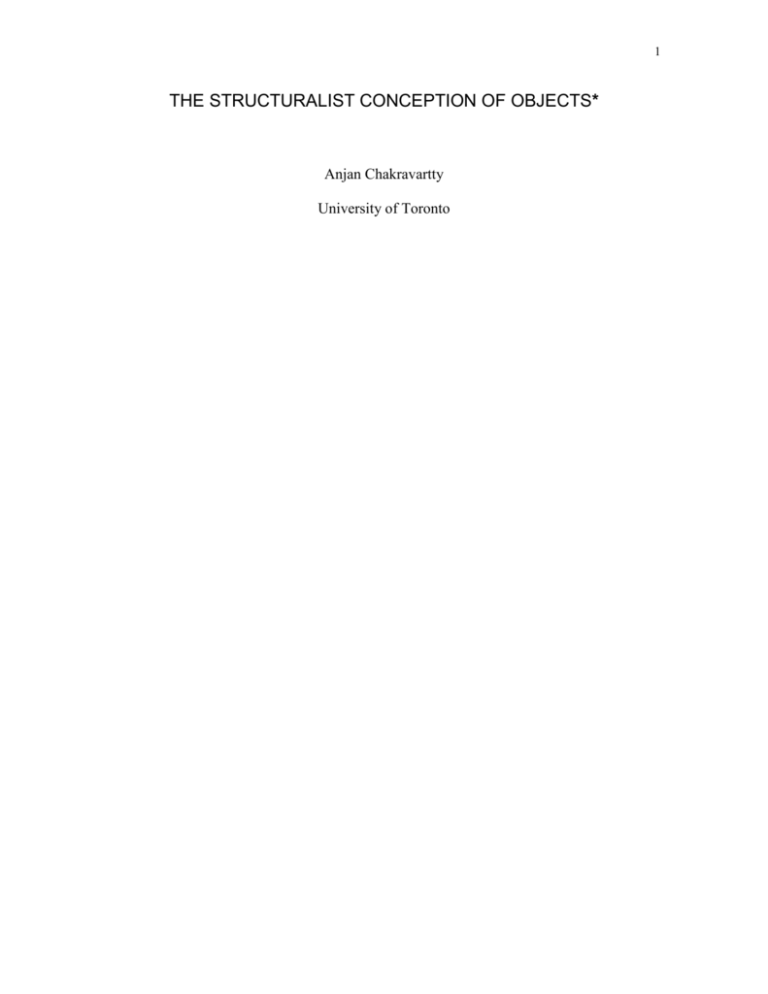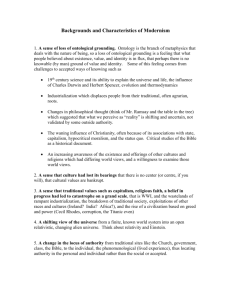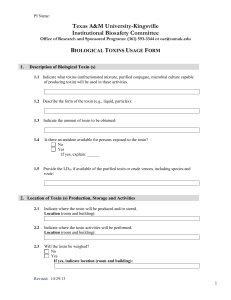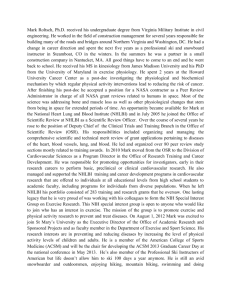The Structuralist Conception of Objects - PhilSci
advertisement

1 THE STRUCTURALIST CONCEPTION OF OBJECTS* Anjan Chakravartty University of Toronto 2 Abstract This paper explores the consequences of the two most prominent forms of contemporary structural realism for the notion of objecthood. Epistemic structuralists hold that we can know structural aspects of reality, but nothing about the natures of unobservable relata whose relations define structures. Ontic structuralists hold that we can know structural aspects of reality, and that there is nothing else to know objects are useful heuristic posits, but are ultimately ontologically dispensable. I argue that structuralism does not succeed in ridding a structuralist ontology of objects. 3 1. Structure Wars: ESR versus OSR 1.1 Metaphysics, epistemology, and scientific realism Structural realism (SR) is the view that insofar as scientific theories offer true descriptions of reality, they do not tell us about the natures of things underlying the phenomena. Rather, they tell us about its structure. Informally, the idea of a structure is generally understood in terms of relations that obtain between the elements of some system of elements. Structuralism focuses on the relations themselves, rather than on any putative relata. What is more formally or precisely meant by ‘structure’, however, is not agreed amongst advocates of SR. The position currently comes in two flavours: epistemic (ESR), and ontic (OSR).1 ESR places a restriction on scientific knowledge; proponents hold that we can know structural aspects of reality, but nothing about the natures of unobservable things whose relations define structures in the first place. OSR, more radically, does away with objects altogether; proponents hold that at best we have knowledge of structural aspects of reality, because there is in fact nothing else to know. Here we have the denial of any traditional metaphysics of objects.2 One might wonder how a species of scientific realism, debates about which are traditionally epistemological debates, gives rise to a metaphysical constraint concerning objecthood. It is important to note here a significant difference in the motivations for ESR and OSR. The motivation for ESR is epistemological. Its advocates maintain that, as an epistemological refinement of a more full-blooded realism, the position offers a compelling response to the antirealist’s pessimistic induction on the history of scientific theories. While advocates of OSR likewise hope to respond to antirealist scepticism, the motivation for their revisionary metaphysics has its source in the philosophy of modern physics. It is for this reason 4 that the two positions differ significantly with respect to matters of fundamental metaphysics. In this paper I consider whether SR offers genuine reasons for thinking that we ought to revise what might be regarded as a basic ontological commitment to the existence of objects in general, and more specifically, to some of the objects of scientific discourse. I will argue that it does not. To begin, I briefly consider whether and how ESR and OSR might be thought to constrain the ontology of objects. I will attempt to show that there is no such constraint in the former case, and that in the latter, attempts to derive ontologically decisive conclusions are suspect. What SR suggests is not that objects do not exist, but rather that objects should be understood structurally. The issue of how one gets from the relata of detected relations to a conception of objecthood may well depend on the objects and problems under investigation. On a structuralist account, I will suggest, objects are best thought of as comprising a heterogeneous kind. 1.2 ESR on objects Is there any sense in which SR taken as an epistemological restriction on theoretical belief might have implications for the ontology of objects? In earlier work, current advocates of ESR invoke Poincaré as their inspiration, but more recently John Worrall and Eli Zahar have modelled their position on Russell’s structuralism. In particular, their recent defence of SR adopts Maxwell’s use of Ramsey sentences as a means of realizing Russellian structuralism. 3 An unobservable entity whose place is held by a predicate variable in a Ramsey sentence is “whatever it is” that satisfies the relations specified by the sentence. This ‘indirect’ reference is achieved by ‘purely logical terms (variables, quantifiers, etc.) plus terms whose direct referents are items of acquaintance [i.e. observables]’ (Maxwell 1970a, 16). We do not know what the 5 natures of theoretical entities are, but we can assert that they exist and stand in certain relations. ‘This…may be taken as an explication of the claim of Russell and others that our knowledge of the theoretical is limited to its purely structural characteristics and that we are ignorant concerning its intrinsic nature’ (Maxwell 1970b, 188). Russell’s structuralist epistemology has recently come under close critical scrutiny (e.g. Demopoulos & Friedman 1985), but for present purposes let us simply note that nothing regarding the ontology of external particulars follows from this proposal. ESR attempts merely to restrict what can be known about unobservable things to properties of their relations. But that is to say nothing about the ontological status of these things other than that they exist and do, ex hypothesi, stand in relations. Given this, there may be non-empirical truths that we can know about these particulars we might argue, for example, about whether they are substrata in which properties inhere, bundles of properties or tropes, or brute particulars. But these debates are a priori in character, premised on the existence of their subject matter. ESR does not foreclose various, well-known possibilities as to the precise ontology of objects. 1.3 A phantom menace?: OSR on objects Unlike ESR, OSR imposes a severe constraint on the nature of objecthood: it rules out the possibility of objects as a genuine ontological category. Advocates of OSR hold that realists should believe only in structures described by theories, because structure is all there is to reality. The more traditional realist’s talk of objects is misguided, engendering, it is claimed, fatal metaphysical difficulties. Proponents of this position are happy to speak of objects (like electrons), but only as a façon de parler. And this way of speaking, properly interpreted, is subject to what they view as a more enlightened metaphysical picture. An integral part of this 6 picture is the idea that objects, conceived of as bearers of properties that stand in relations, are metaphysically otiose. The case for OSR proceeds from the interpretation of quantum mechanics (QM). QM appears to underdetermine the nature of quantum particles as regards their identity, or individuality. This underdetermination, it is claimed, is fatal to any realism other than OSR.4 Macroscopically and in classical physics, we think of objects as having identities which distinguish them from other things. This notion of individuality is reflected in classical, Maxwell-Boltzmann statistics, which recognize different permutations of objects as distinct arrangements. It is unclear, however, whether quantum statistics respect individuality. Consider the possible arrangements of two particles of the same kind (i.e. having the same stateindependent properties such as mass, charge, spin) distributed across two energy states. Neither Bose-Einstein nor Fermi-Dirac statistics count particle permutations as constituting different arrangements. Interchanging the particles has no physical significance according to QM. This suggests that QM objects are not objects in the classical or everyday macroscopic sense, and generates a dilemma concerning their putative objecthood. One might hold that quantum particles are peculiar individuals: ones that appear to violate Leibniz’s principle of the identity of indiscernibles (PII). Unlike classical objects, quantum objects appear to violate even weak versions of PII, for QM state functions describing assemblies of particles attribute to them all of the same intrinsic and relational (e.g. spatio-temporal) properties.5 On the other hand, one might hold that quantum particles are not individuals at all, but non-individuals of some sort. This interpretation is favoured by some who view “particles” as excitation events in a quantum field. 7 It is argued that these two different understandings suggested by QM with respect to the nature of objecthood are underdetermined by the theory. Granting this, what is the significance of this underdetermination? James Ladyman and Steven French contend that the mere fact of underdetermination scuppers any form of realism involving objects, for ‘[i]t is an ersatz form of realism that recommends belief in the existence of entities that have such ambiguous metaphysical status’ (Ladyman 1998, 420). OSR is immune to this worry, because it makes no recommendation on behalf of objects. It advocates a conception of reality according to which objects are relinquished in favour of structures taken as ‘primitive and ontologically subsistent’. 2. The Properties Strike Back 2.1 Ontological theory change, dependence, and sociability Object talk permeates not merely everyday but also scientific discourse to such an extent that the contention that it is empty cannot help but seem deeply revolutionary. We quantify, generalize, and perform inductions over putative objects with such abandon that any picture of reality according to which these practices are metaphysically confused should be required to meet, I suggest, high standards of persuasion. Before we agree to the ontological revision demanded by OSR, let us think carefully about the sorts of methodological principles that might convince us that such a step is required. I suggest that ontological revision on this scale is poorly recommended unless the substitution of one ontological framework for another satisfies at least some principles that one might reasonably accept as governing theory change with respect to ontology. These principles, I believe, must include the following: 8 (i) need: there is a compelling reason to reject the entrenched ontological framework (ii) explanatory role: the replacement framework is explanatorily stronger; i.e. it serves the same and further explanatory functions (iii) primitives: the replacement framework is less obscure; i.e. it incorporates fewer primitive notions In the remainder of this section and the next, I will argue that a switch to the ontological framework of OSR satisfies none of these principles. Consider first the need principle. I have argued elsewhere that the mere fact of QM underdetermination of the nature of quantum particles with respect to individuality is insufficient to recommend OSR. The situation regarding particles is analogous to the situation regarding everyday observables, whose ontology and individuality OSR must (for the sake of consistency) also view as underdetermined by physics. Yet this latter underdetermination does not, it seems, compel us to relinquish objects as an ontological category. Though the need principle is what proponents of OSR appeal to most strongly, I will not review this argument here. For even if it were satisfied, the need principle is not sufficient to recommend OSR. This is because it concerns only the rejection of one ontological framework, and the rejection of one does not ipso facto recommend a rival. For the present, let us simply note that whether the argument for OSR demonstrates that the need principle is satisfied is a matter of controversy. 9 Consider, then, the explanatory role principle. It might be thought that the ontological picture suggested by OSR is incoherent. This I think is a natural first response. Given that structures are defined by relations, and that relations require relata in order to be instantiated that is, to be part of the world of interest to scientific realists, as opposed to merely abstract, mathematical entities OSR demands a belief in the existence of concrete relations coupled with a belief in the non-existence of the relata on which they depend, and this is contradictory. We might think of this form of relation-relata dependence as a conceptual dependence. It is part of the very concept of a concrete relation that it relate something. According to our concepts of these things, the former cannot exist without the latter, and in this sense, objects play an important, constitutive, explanatory role in our notion of structure. As noted above, however, this explanatory role is not one that OSR can be expected to duplicate, on pain of contradiction. But then, one might argue, this particular explanatory function is not one that we can reasonably expect OSR to serve, given that its central claim is a denial of the existence of objects. OSR recommends that we revise our concepts in such a way as to view relations as ontologically subsistent, even in the realm of the concrete. To argue against OSR on the basis of a violation of conceptual dependence is thus, it seems, question begging. There is another form of relation-relata dependence, however, that the ontologically unadventurous might exploit in connection with the explanatory role principle, and without begging the question against OSR. We might call this a causal dependence. One of the most important explanatory roles served by objects is to provide a means of change. Objects have properties, and it is because they have these properties that things happen to them. Indeed, the mathematical equations that typify law statements in physics are generally equations that are interpreted as representing relations between properties of objects. If we increase the pressure, 10 says Boyle’s law, the ratio of the temperature to the volume must also increase. If we apply a force, says Newton’s second law, the body must experience an acceleration that is proportional to the force and inversely proportional to the mass. Objects with properties are thus explanatorily central in the entrenched ontological framework. How does an object-less ontology account for change? Unlike the case of conceptual dependence, causal dependence represents a non-question begging difficulty for the proponent of OSR. It is reasonable to expect any account of scientific realism to possess the ontological resources with which to explain how we get from one state of affairs to another. If one accepts the ontological framework of OSR, one appears to be left with explanatory gaps missing links between subsequent states of affairs. Given a concrete instance of some set of relations, we have no explanation for what constitutes the active principle that transforms this set of relations into another. In the entrenched ontological framework, the “nodes” of structures are no mere phantoms, posited for heuristic reasons but then relinquished by careful metaphysicians. They have ontological clout. The natures of properties give us something on which to hang explanations of change. (Indeed, many including myself think of these properties dispositionally.) If we take the slogan ‘relations without relata’ seriously, however, the replacement framework seems to have insufficient resources with which to provide the desired explanations. Unable to supply these missing links, OSR thus runs foul of the explanatory role principle. The argument from causal dependence fares better than the argument from conceptual dependence, but it is not conclusive. Not all versions of the entrenched ontological framework recognize the need for ‘active principles’ of the sort mentioned above, with which to provide explanatory links between states of affairs. Those with a taste for desert landscapes, for 11 example, are happy to analyze events in terms of brute successions of states of objects. Along with others who are non-Humean in this respect, I do not share the appreciation of such landscapes the terrain is too barren of explanation for my liking but if this possibility is to be admitted, then a similar strategy is available to the proponent of OSR. Events might be analyzed in terms of brute successions of structures, as proponents of OSR conceive them. Conversely, those who are convinced of the demand for explanations of change will find the Humean picture unsatisfactory, whether in its traditional guise, or dressed up in the form of OSR. Perhaps the best reason for thinking that objects are ontologically significant is the empirical discovery that certain groups of properties tend to cohere. A particular set of properties, for example, come together as a package to constitute electrons, whether we construe this particular as a particle or an excitation event. These sets of properties seem to like one another’s company; they are always detected together coincidence, or object? Again, it is reasonable to expect a tenable version of scientific realism to offer some explanation for empirical regularities of this sort. On an object-based ontology, we have an explanation for why the potential for certain types of structural relations are tied together: the properties that confer dispositions for these relations cohere in the form of an object. On the ontological picture sketched by OSR, it is unclear what could serve to provide a parallel explanation. In fact, this sort of challenge to satisfy the explanatory role principle applies not merely in connection with collections of properties (objects), but in connection with specific properties as well. A given property is generally capable of figuring in not just one, but many different kinds of relations. In the entrenched ontological framework, this fact is explained: properties are “many-faceted”; they confer dispositions on the things that have them for different sorts of relations in different circumstances. We associate collections of these possibilities with one and 12 the same property; they are part (according to some views, all6) of what makes a property the property that it is. Conversely, on the framework of OSR, it is unclear why some of what must be regarded as ontologically insignificant “nodes” occurring in different structures should be identified with one another. Here too, OSR fails to satisfy the explanatory role principle. 2.2 Tu quoque Before considering the third principle suggested for assessing the desirability of a revolution in ontology the primitives principle let us remind ourselves of what OSR takes to be problematic about ontologies involving objects. It is the fact that QM underdetermines the nature of quantum particles as regards their individuality that is taken to cast doubt on more traditional forms of realism. A realism that admits the existence of such metaphysically ambiguous entities, it is held, is not worth retaining. I will argue, however, that physics does furnish resources which allow for an object-accepting realism. What is crucial to this understanding is that scientific realism is properly, first and foremost, a realism about properties. I will suggest here and in the next section that how objects are “constructed” from properties is open to a degree of classificatory convention; if properties are amenable to collection into different sorts of objects (or more generally, particulars), this hardly undermines objects as a genuine ontological category. The worry expressed by proponents of OSR concerns the notion of individuality. What do we require of the concept of an individual, or a particular? A particular is a unity in spacetime; it is something that coheres, and has a location. (Granted, it is often held that particulars should placate other intuitions as well, but these are controversial and widely disputed; I will catalogue them shortly.) I have suggested that the relata of relations defining structures are 13 properties in the first instance. An immediate question then arises as to which particulars have these properties. This question can be answered in different ways, without compromising a realist attitude toward theories. OSR describes one of the underdetermined options in terms of individuals that violate PII. On this option, some form of haecceity is required to distinguish the particles. Now consider the second underdetermined option, which OSR describes as invoking ‘non-individuals’? Here “particles” are interpreted as excitations in a quantum field. But excitations are events, and events are particulars.7 Far from doing away with individuality, the second underdetermined option collects properties (that we might otherwise collect together as objects) in a different way: it collects them together as particular events. The moral here is that however realists choose to construct particulars out of properties, they do so on the basis of a belief in the existence of those properties. That is the bedrock of realism. Properties lend themselves to different forms of packaging, but as a feature of scientific description, this does not by itself compromise realism with respect to the relevant packages. This is not to say, of course, that there are never reasons for adopting or rejecting some packages or preferring some to others. Reasons may be empirical, as when particular problem solutions favour particular ways of describing the phenomena, or theoretical, whether the relevant concerns arise from physics or metaphysics. But given that OSR seeks specifically to problematize the metaphysical status of objects, let us continue for the moment to focus our attention here. Let us consider the matter of individuality on what I have been calling the entrenched ontological framework, and see whether the replacement framework of OSR is any more compelling with respect to the primitives principle. It is no small question how, on the entrenched framework, different properties cohere so as to constitute an individual (a particular, whether an object or an event). What is it that makes 14 a collection a unity? Without doing justice to the nuances of carefully articulated positions, we may divide the traditional views on objects into two broad camps, each of which has two main branches. The broad division is between realism about universals and nominalism. Views on universals further subdivide into theories that account for individuals in terms of substrata instantiating properties, and bundle theories. Nominalism subdivides into traditional varieties which view particulars as further unanalyzable, and trope theories which describe particulars as bundles of tropes. I cannot consider these possibilities in any detail here; the point of raising them is merely to note certain aspects which may be regarded as fundamentally mysterious and unsatisfactory, or further unanalyzable and acceptable, depending on which position one adopts. The current aim is not to champion any one of these views, so let us refer to these aspects neutrally as ‘primitives’. The unity of an object on the substratum view is conferred by the bare substratum, the ‘something-I-know-not-what’. Not only is the nature of the bare particular in principle unknowable, but the nature of the instantiation relation, the manner in which properties inhere in the substratum, defies further analysis. Individuality is understood in terms of individual essences or haecceities, whether ‘thick’ (something “property-like”, though not a property) or ‘thin’ (brute numerical difference). The bundle theory does away with substrata, but supplies another primitive in the relation of compresence or collocation, which then becomes the basis of its account of individuality. For the nominalist, particularity is itself a primitive notion, as are resemblances between particulars. Trope theory adopts this attitude toward property instances, which have a brute particularity, and can be less or more (up to a maximum of exactly) similar to one another. Bundles of tropes, like bundles of properties construed as universals, stand in a primitive relation of compresence. 15 Does the ontological framework of OSR furnish a less obscure set of fundamental notions than traditional views of the framework it hopes to replace? It is difficult to see how it could. To the charge that an object-bound scientific realism recommends entities of a metaphysically ambiguous nature, one might respond: tu quoque. Structures are defined by relations, and the metaphysical ambiguities that afflict objects are applicable to relations also. One might wonder whether the relations of SR are universals, or to be understood in terms of nominalism. It is unclear how the resemblance of one instance of structure to another, whether it occurs in the same lab at a different time or in another lab altogether, is to be analyzed, if at all. What constitutes the individuality of an instance of structure? There had better be an answer to this question, for instances of structure are no less particular than the objects OSR seeks to replace. The answer to this question, however, is underdetermined by physics. Things subject to empirical investigation naturally raise questions of individuality, whether they are objects, events or on the ontological framework of OSR, instances of structure. Given that the nature of structures is underdetermined by physics, one might even be tempted to say that ‘it is an ersatz form of realism that recommends belief in the existence of entities that have such ambiguous metaphysical status’. I am not, however, tempted. The idea of an object-less ontology is a fascinating, if conceptually puzzling, metaphysical program, in the early stages of articulation. What it has not done (and indeed, it is difficult to see how it could) is demonstrate that forms of realism based on a more traditional ontological framework are any more compromised by metaphysical ambiguity than itself. As a recommendation for ontological revolution, OSR fails to satisfy the primitives principle. 16 3. Return of the Object Perhaps an ontological relativity of the sort suggested by Putnam’s internal realism is an appropriate attitude for the scientific realist not toward the world in general, but toward some of the attempts to come to grips with fundamental ontology outlined above. From the realist perspective, one might regard these systems as different, basic accounting methods for keeping track of the same mind-independent, external stuff. To the extent that this sort of attitude is sufficient for the realist, pragmatic as opposed to purely epistemic criteria will be important to any comparative assessment of rival ontological frameworks for characterizing particulars. The principles offered in Section 2 are examples of pragmatic criteria that are likely to feature centrally. The ontological framework of OSR is not preferable to a more traditional, objectconducive framework. How we think about objects things that have properties is an important question, but there is no obvious a priori reason to think that just one account should apply across the board. Quantum objects, if there are any, may not be the same sorts of objects as macroscopic objects. Some of what qualify as “objects” are countable (proteins, cells), but others are merely quantifiable (plasma, light). Some appear to persist in time, others may exist only in the context of specific events during which their properties are instantiated. It is likely that the question of how we get from properties to objects is best answered in different ways, depending on the objects in question. Objects in general comprise a heterogeneous kind. Quine 1976 argues that when we consider fundamental ontology carefully, we find that objects ultimately wither away, and we are left with nothing more than regions of space-time with properties. Unqualified, however, this conclusion is overly dramatic. The fact that we 17 often group properties conventionally does not render the groupings unreal, any more than biological species are unreal despite the fact that they are demarcated conventionally. An innocuous anthropocentrism should not be taken to imply a worrying “unreality”. But there is another sense in which descriptions of the fundamental natures of things may vary. In addition to the heterogeneity of kinds of objects, our ontological characterizations of one and the same particular may vary, depending on the sorts of questions we are attempting to answer. I suggest that the reason we are able, and in fact sometimes may be required, to characterize cohering collections of properties in different ways (e.g. electrons as particles versus excitation events) is that they are dispositional. We generally describe dispositions in terms of their manifestations, and particular manifestations occur only in particular kinds of circumstances. That is why different ontological conventions may be better suited to describing different investigations or problem types: descriptions of particulars are often descriptions of dispositions that are relevant to particular kinds of interactions, measurements, and investigations. The same properties can be investigated in different ways, and the results are sometimes best described in terms of different ontological categories of particulars. If there is something important to be learned from SR, it is not that there is only structure. Rather, it is that relations between things are of paramount importance in connection with scientific knowledge. It is only by means of these relations that we learn anything at all our knowledge is constrained by the relations of which things capable. As a consequence, scientific knowledge is primarily about these relations, and (I would add) the dispositions things have to enter into different kinds of relations under different circumstances. But whether this prescription is cogent, and whether it is sufficient to distinguish SR from other forms of realist commitment, are questions that require more consideration than I can give here. 18 References Demopoulos, W., and M. Friedman (1985), “Critical Notice: Bertrand Russell’s The Analysis of Matter: Its Historical Context and Contemporary Interest”, Phil. Sci. 52: 621-639. French, S. (1989), “Identity and Individuality in Classical and Quantum Physics”, Austral. J. Phil. 67: 432-446. (1998), “On the Withering Away of Physical Objects”, in E. Castellani (ed.), Interpreting Bodies: Classical and Quantum Objects in Modern Physics, Guildford: Princeton UP, 93113. French, S., and J. Ladyman (forthcoming), “Remodelling Structural Realism: Quantum Mechanics and the Metaphysics of Structure”, Synthese. Huggett, N. (1997), “Identity, Quantum Mechanics and Common Sense”, Monist 80: 118-130. Ladyman, J. (1998), “What is Structural Realism?”, Stud. Hist. Phil. Sci. 29: 409-424. Maxwell, G. (1970a), “Theories, Perception, and Structural Realism”, in R. G. Colodny (ed.), The Nature and Function of Scientific Theories, U Pittsburgh P. (1970b), “Structural Realism and the Meaning of Theoretical Terms”, in M. Radner & S. Winokur (eds.), Minnesota Studies in the Philosophy of Science, vol. 4. Minneapolis: U Minnesota P. Quine, W. V. O. (1976), “Wither Physical Objects”, in R. S. Cohen, P. K. Feyerabend, and M. W. Wartofsky (eds.), Essays in Memory of Imre Lakatos, Dordrecht: Reidel. Russell, B. (1927), The Analysis of Matter. London: Kegan Paul, Trench, Trubner & Co. (1948), Human Knowledge: Its Scope and Limits. London: George Allen & Unwin. 19 Shoemaker, S. (1980), “Causality and Properties”, in Time and Cause, P. van Inwagen (ed.), Dordrecht: D. Reidel. Swoyer, C. (1982), “The Nature of Natural Laws”, Austral. J. Phil. 60: 203-223. van Fraassen, B. C. (1991), Quantum Mechanics: An Empiricist View. Oxford: Clarendon. Worrall, J. (1989), “Structural Realism: The Best of Both Worlds?”, Dialectica 43: 99-124. Zahar, E. G. (1996), “Poincaré’s Structural Realism and his Logic of Discovery”, in J-L Greffe, G. Heinzmann and K. Lorenz (eds.), Henri Poincaré: Science and Philosophy, Berlin: Akademie Verlag & A. Blanchard, 45-68. 20 Footnotes 1 The distinction is due to Ladyman 1998. The same distinction is found in Psillos 2001 under the labels ‘restrictive’ and ‘eliminative’ SR respectively. 2 ESR is defended in Worrall 1989, Zahar 1996; and OSR in Ladyman 1998, French 1998, French & Ladyman (forthcoming). 3 See fn. 2, 3, Russell 1927, 1948, Maxwell 1970a, 1970b. 4 See French 1989, van Fraassen 1991, Huggett 1997. Regarding underdetermination, see OSR references, fn. 2. 5 Individuality might then be understood in terms of individual essences (haecceity, primitive this-ness) as opposed to determinate properties. I will return to this possibility in Section 3. 6 See Shoemaker 1980, Swoyer 1982. 7 Thanks to Jeremy Butterfield for reminding me that Davidsonian events are no less particular than objects. Quine holds similar views.








